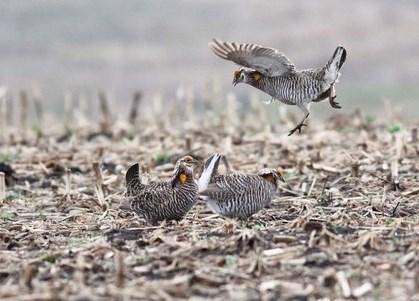
Xplor reconnects kids to nature and helps them find adventure in their own backyard. Free to residents of Missouri.


































Stay in Touch with MDC news, newsletters, events, and manage your subscription

Xplor reconnects kids to nature and helps them find adventure in their own backyard. Free to residents of Missouri.

A monthly publication about conservation in Missouri. Started in 1938, the printed magazine is free to residents of Missouri.


Eagleville, Mo. – The first long, haunting "oooomph, oooomph" filled foggy darkness just before dawn, as a male prairie chicken announced his presence on a Harrison County hilltop. Moments later, another male arrived and puffed out the orange air sacs on his neck to make a mating call that resembles an exotic acoustic musical note. Then more joined in, creating a haunting chorus as sunrise made their foot-stomping dances and territorial jousts visible.
"They're everywhere," an onlooker whispered, watching from a blind on April 19 at a lek at Dunn Ranch Prairie in northwest Missouri.
So it seemed, with 15 or more males visiting the mating ground in hopes hens would come. These leks have long been called booming grounds for the sounds the males make in courtship and in defense of the turf they temporarily claim on the leks. Up close, the sound is more like a croon. But perhaps when the greater prairie chicken populations on the hilltops numbers hundreds and thousands of birds before their decline in the 1800s due to habitat loss, the cumulative sound at a distance did sound like the booming of drums or cannon.
Greater prairie chickens are now endangered in Missouri and in Iowa, which is just north of Harrison County. The birds at Dunn Ranch and flocks at Taberville Prairie and Wah'Kon-Tah Prairie in west central Missouri are the only current notable populations. But biologists are encouraged that habitat management and translocation of Nebraska prairie chickens is boosting the flock anchored by The Nature Conservancy's Dunn Ranch and the Missouri Department of Conservation's (MDC) Pawnee Prairie Natural Area.
MDC biologists and staff for the Conservancy recently drove the Harrison County backroads at sunrise to listen and look for prairie chickens. The count noted 47 prairie chickens at seven different leks, up from 40 birds found on five leks last spring. Most were males booming on leks at Dunn Ranch. Others were at Pawnee Prairie or on private farms. Other birds, especially hens, are in the area but were not on the leks during the count.
"This year's greater prairie chicken count revealed that numbers were higher and the birds were distributed over a larger geography when compared to last year," said Kendall Coleman, MDC private land conservationist. "With the translocated birds added to the population, we are very optimistic about the coming nesting season."
Dunn Ranch and Pawnee Prairie are centerpieces in a broad cooperative effort with partners in Missouri and Iowa called the Grand River Grasslands. MDC trapped 100 prairie chickens this spring in Nebraska. Sixty of those birds were released at Dunn Ranch and 40 were released in Iowa.
MDC works with conservation partners and private landowners to boost habitat for prairie chickens and all native grassland species. Research is helping biologists determine the varied plant species and vegetation heights that prairie chickens need to successfully nest, raise broods, feed and survive through all seasons. Hens released in the translocation program were outfitted with small radio transmitters. Biologists will be tracking the birds to determine their movements, habitat preferences and brood rearing success.
Prairie chickens are endangered in Missouri because only a tiny fraction of the state's once-vast prairies remain. Remnants are in isolated tracts. But MDC's prairie chicken recovery programs in the Grand River Grasslands and the Upper Osage Grasslands are making progress on public and private grasslands to provide significant habitat for ground-dwelling birds and the native plants that support them.
For more information on prairie chicken programs in Missouri, visit nature.mdc.mo.gov/discover-nature/field-guide/greater-prairie-chicken.